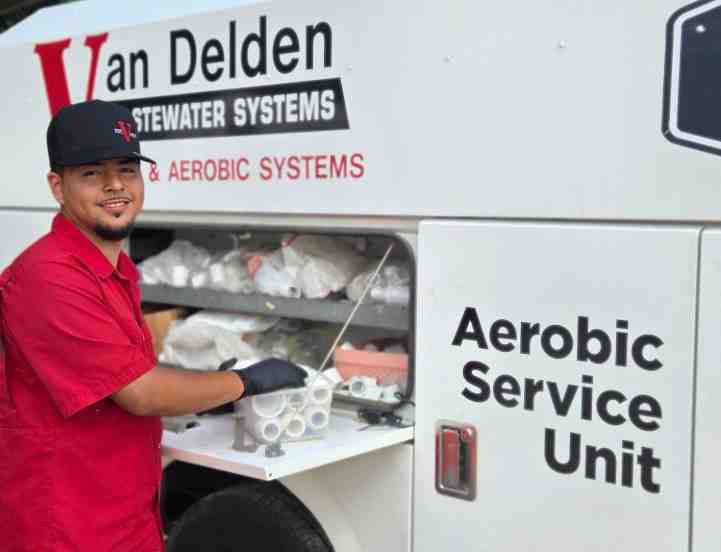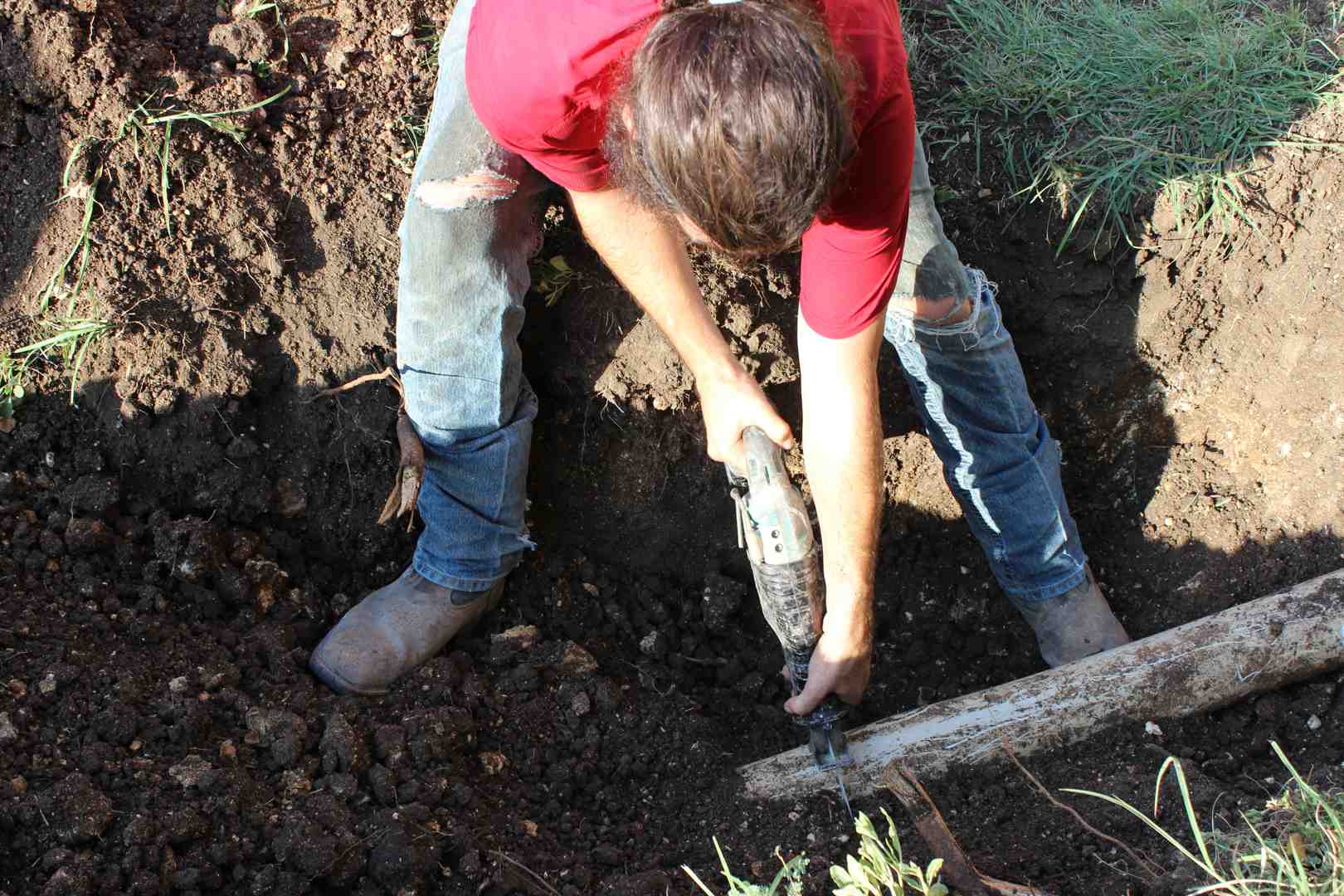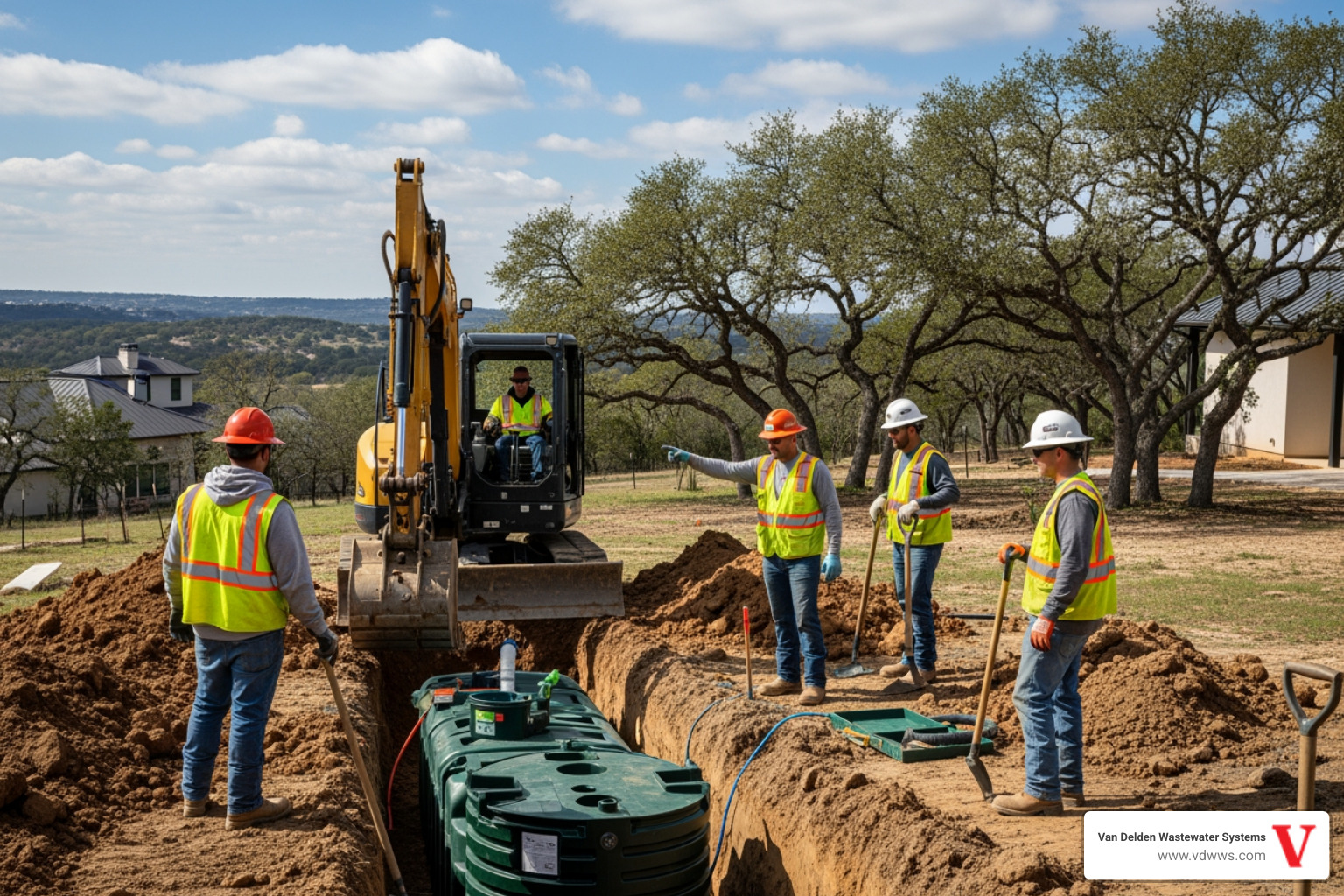Why Recognizing Drainfield Problems Early Matters Most
Drainfield failure signs are your septic system's cry for help. Catching them early can save you thousands of dollars in repairs. Your drainfield is the final stage of wastewater treatment, and when it starts failing, the signs become impossible to ignore.
The most common drainfield failure signs include:
- Sewage odors around your yard or septic tank area
- Standing water or soggy patches over the drainfield, especially during dry weather
- Unusually lush, green grass in patches over the drainfield area
- Slow drains throughout your house or gurgling sounds from plumbing
- Sewage backups in toilets, sinks, or showers
- Black, slimy substances appearing on the ground near your system
Septic systems require routine maintenance. Unlike a leaky faucet, a failing drainfield poses serious health risks and can contaminate groundwater with harmful bacteria and viruses.
Most drainfield problems start small and provide plenty of warning. Early detection is your best defense against costly emergency repairs and potential health hazards.
Whether you're dealing with obvious signs like sewage odors or subtle clues like greener grass, understanding what to look for helps you take action before a minor issue becomes a major disaster.
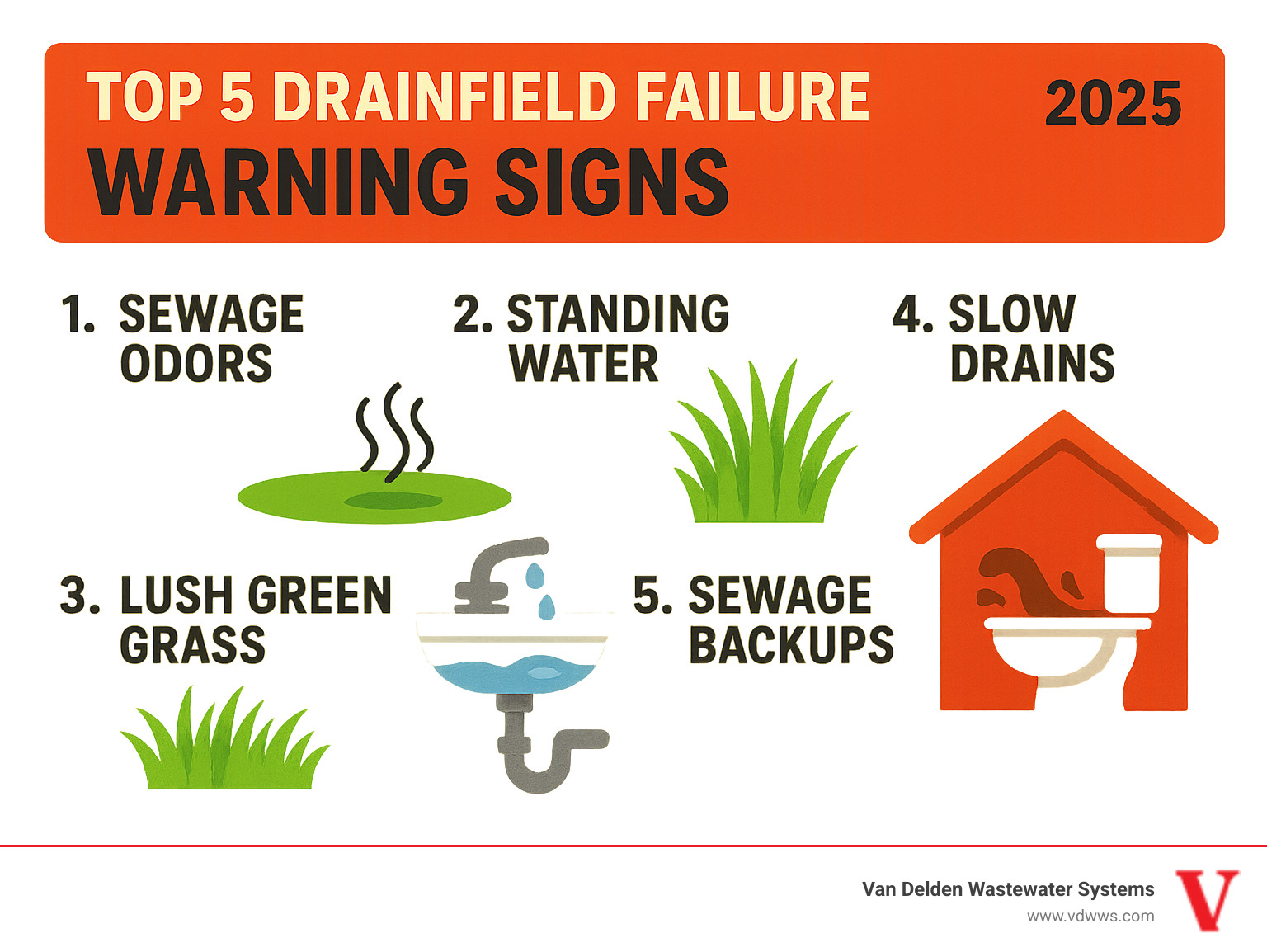
Key Drainfield Failure Signs to Watch For
Recognizing drainfield failure signs comes down to paying close attention to your home's plumbing and your yard's appearance. While some signs are obvious, others are subtle. Our goal is to empower you to spot these indicators early and become a proactive protector of your property.
Unpleasant Odors and Soggy Ground
One of the first and most unmistakable drainfield failure signs is the unpleasant smell of sewage or rotten eggs (hydrogen sulfide) in your yard. This indicates untreated wastewater is surfacing because it's not being absorbed by the soil.
Beyond the smell, keep an eye out for visual cues:
- Standing Water or Soggy Patches: Puddles or consistently soggy ground over your drainfield, especially in dry weather, are a major red flag. It means the soil is saturated and can no longer absorb wastewater, causing it to surface.
- Spongy Ground: A drainfield that feels spongy underfoot, even without visible puddles, suggests oversaturation just beneath the surface.
- Black Slimy Substance: A black, slimy substance on the ground is raw sewage. This indicates a complete drainfield failure and is a significant health hazard.
If you detect foul odors or find wet areas near your septic system, it's time to investigate. For more local insights, see our article on Signs of Drainfield Problems in San Antonio Home.
Plumbing Backups and Slow Drains
Your indoor plumbing offers crucial clues to drainfield failure signs. If the drainfield can't absorb water, the entire system backs up into your home.
Here's what to watch (and listen) for:
- Slow Draining Sinks, Tubs, and Toilets: If sinks, tubs, and toilets drain slower than usual, it's an early warning. Wastewater has nowhere to go in an overwhelmed drainfield, causing a backup.
- Gurgling Sounds: Gurgling sounds from drains after flushing or use indicate trapped air from poor drainage.
- Toilets Not Flushing Properly: Toilets that require multiple flushes or seem sluggish signal that the system is struggling to accept more water.
- Sewage Backups into Home: Sewage backing up into sinks, tubs, or onto floors is the most alarming sign. This indicates a catastrophic failure, is a severe health hazard, and requires immediate professional help.
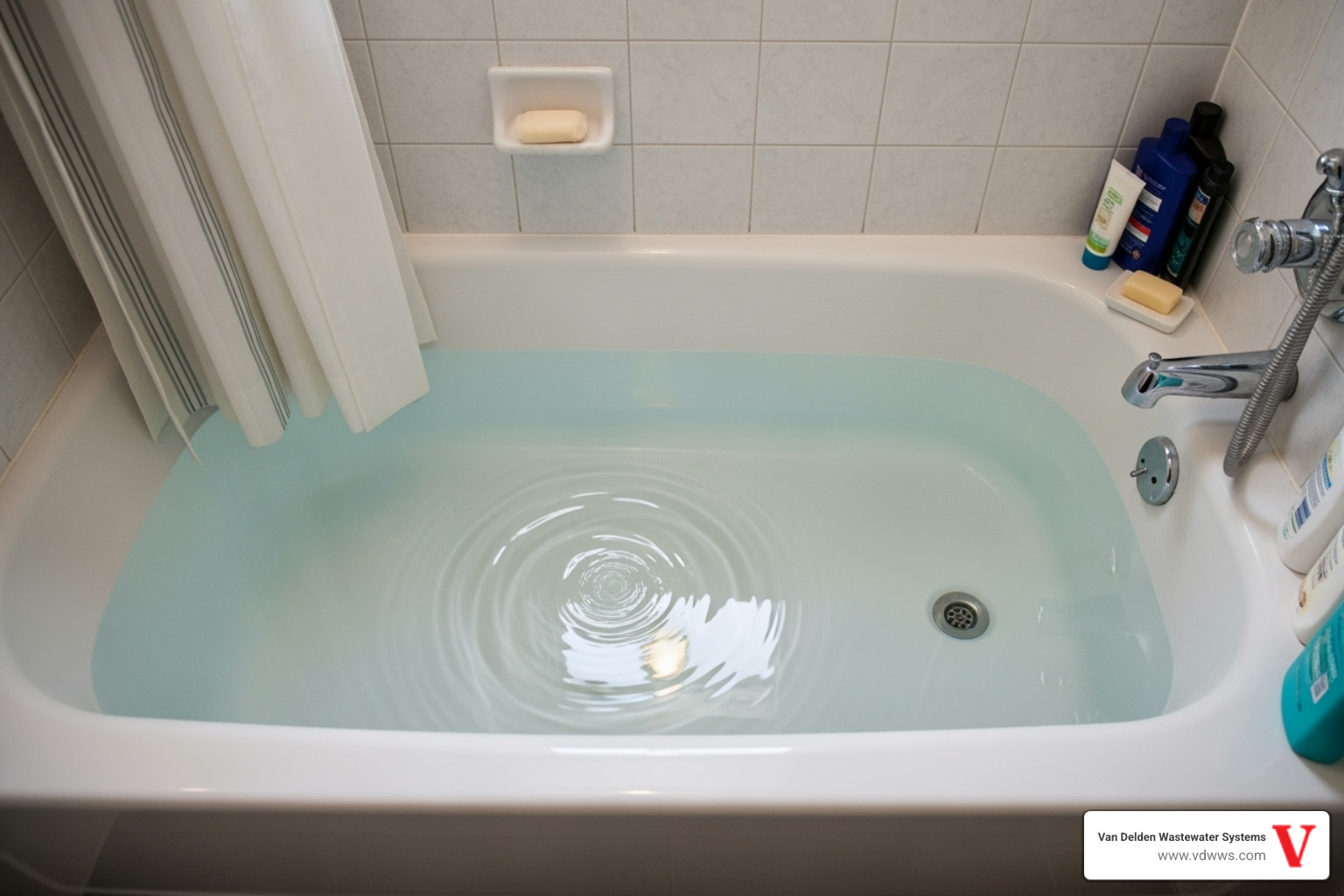
While a single slow drain might be a localized clog, widespread slow drainage strongly points to a septic system issue, with the drainfield often being the culprit.
Changes in Your Yard's Appearance
Counterintuitively, a classic drainfield failure sign is grass that looks unusually healthy in specific patches.
Keep an eye out for:
- Unusually Lush, Green Grass: A patch of grass over your drainfield that is significantly greener or lusher than the rest of your lawn is a warning sign. Wastewater contains nutrients that act as fertilizer, indicating untreated effluent is seeping to the surface.
- Rapid Weed Growth: A sudden explosion of weeds in the same area is also a sign, as they thrive on the excess water and nutrients.
- Visible Stripes or Patterns: This lush growth may appear in stripes that mirror the layout of the underground pipes, which is a strong visual clue of a leak or oversaturation.
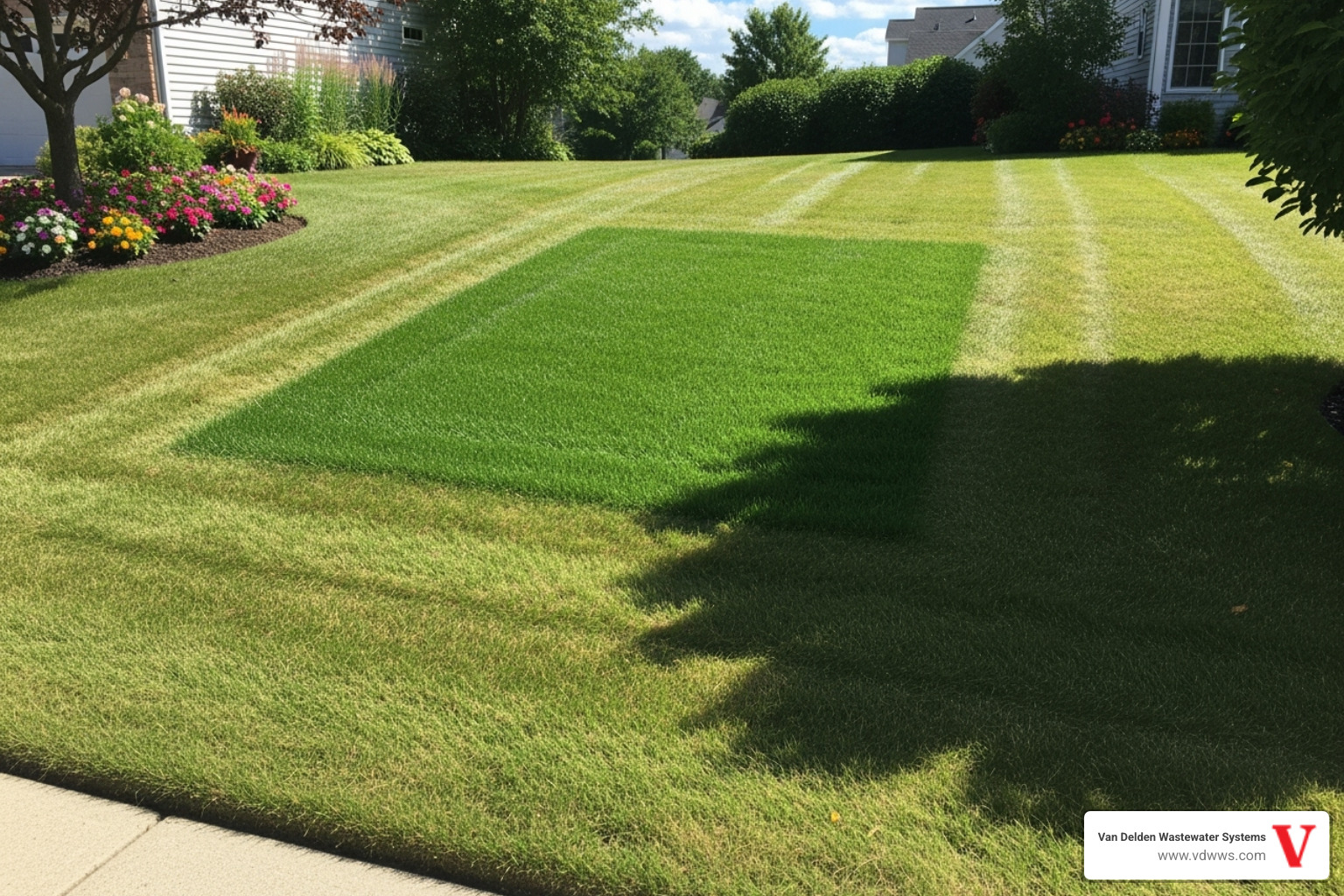
Understanding this unique indicator is crucial for early detection. If you're unsure where your drainfield is, our guide on How to Find My Drainfield can help you pinpoint its location.
What's Causing the Failure? Common Culprits Explained
When you spot drainfield failure signs, you might wonder why it's happening. Drainfield problems are usually the result of factors building up over time, including septic tank health, soil conditions, system age, and maintenance history.
Understanding these common culprits helps you make sense of the signs you're seeing. For a comprehensive look, check out our guide on Common Septic Drainfield Problems.
Poor Maintenance and Tank Issues
Skipping septic maintenance is like ignoring your car's check engine light—it will eventually lead to a breakdown.
Skipped septic pumping is a top cause of drainfield failure. Septic tanks separate liquids from solids (sludge). Without regular pumping (every 3-5 years), sludge builds up and flows into the drainfield. These solids clog the pipes and soil, leading to failure.
Your effluent filter at the tank's outlet catches solids before they reach the drainfield. If it's not cleaned during pumping, it clogs and stops the system's flow.
Biomat formation is a slimy layer of microbes that helps treat wastewater. However, if the system is overloaded or solids enter the drainfield, the biomat can grow too thick, waterproofing the soil and preventing absorption. Our article on Understanding Drainfield Biomat Formation explains this phenomenon.
The bottom line? Regular maintenance is your drainfield's lifeline. For more on maintenance-related failures, see our piece on 4 Common Causes of Septic Drainfield Failure.
Physical Damage and Environmental Factors
Sometimes, a drainfield's biggest enemies are external. Physical and environmental factors can be just as damaging as what goes down the drain.
Soil compaction from heavy vehicles, equipment, or even foot traffic over the drainfield is a major problem. It compresses the soil, preventing it from absorbing wastewater and suffocating the system.
Tree roots are naturally drawn to the water and nutrients in drainfield pipes. They can enter through small cracks, growing until they block or crush the pipes.
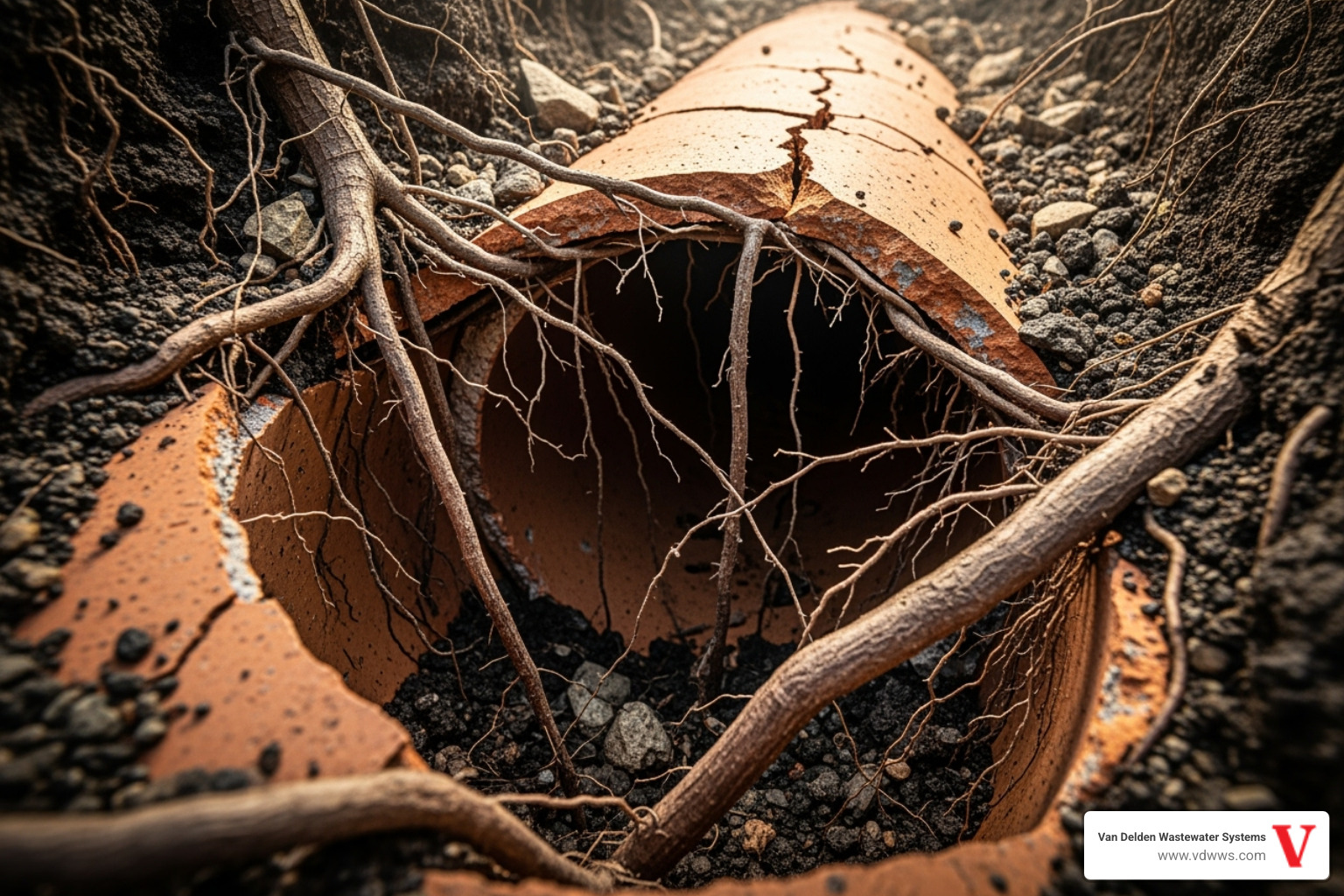
A high water table or heavy rainfall can saturate the soil around the drainfield. When the ground is already full of water, there's no room for effluent, causing it to back up. Our guide on High Water Tables Impact on Drainfields explores this challenge.
Improper design or installation can cause failure from the start. A system not suited for the home's soil type, size, or water usage will struggle.
Protecting your drainfield from these challenges is crucial. For tips, read about Preventing Drainfield Soil Erosion.
System Overload and Improper Use
Overloading your septic system with too much water or the wrong materials will cause it to fail.
Excessive water usage is a common problem. Back-to-back laundry loads, long showers, or even a leaky toilet can flood the drainfield, preventing it from absorbing and treating wastewater properly.
Flushing non-biodegradables like wet wipes (even "flushable" ones), feminine products, or paper towels clogs the system. These items don't break down and cause blockages in the tank and drainfield.
Grease, oils, and fats solidify in pipes and the tank, creating blockages. In the drainfield, they coat the soil, preventing absorption.
Harsh chemicals kill the beneficial bacteria needed to break down waste in the tank. This leads to faster sludge buildup and sends untreated waste to the drainfield.
Using a garbage disposal adds significant solids and grease to your system, increasing the need for pumping and the risk of clogs.
Understanding these usage patterns helps prevent drainfield failure signs. For insights on efficient wastewater distribution, check out our article on Solutions for Uneven Drainfield Distribution.
Suspect a Problem? Here's Your Action Plan
Spotting drainfield failure signs should get your attention, but it doesn't have to cause panic. The worst thing you can do is ignore them. Your game plan is to act quickly and call in professionals.
For a comprehensive guide on tackling these issues, check out our article on How to Diagnose and Fix Drainfield Failures.
When to Call a Professional
Septic systems are not a DIY project. The moment you notice any drainfield failure signs, call a licensed septic professional.
Safety is the top priority. Septic systems contain dangerous gases and pathogens that can cause serious illness or death. Don't risk your health to save money.
An accurate diagnosis is crucial. What seems like a simple backup could be a complex issue. Professionals can trace the problem to its source and determine the extent of the damage.
Professionals use specialized equipment like inspection cameras and high-pressure jetters. They also handle necessary permits and ensure repairs meet local health codes.
At Van Delden Wastewater Systems, our non-commissioned, background-checked technicians provide honest advice. We use detailed service forms and photos to educate you on your system's condition, ensuring you understand the work being done. If you're considering maintenance options, our article on Drainfield Cleaning for Septic System Maintenance is a great place to start.
Understanding the Consequences of Ignoring Drainfield Failure Signs
Ignoring drainfield failure signs only makes the problem more expensive and dangerous.
Environmental damage occurs quickly. Untreated wastewater contaminates groundwater, streams, and lakes with harmful bacteria (E. coli, Salmonella) and nutrients that cause toxic algae blooms.
Health risks are immediate. Raw sewage contains pathogens that cause serious diseases. A sewage backup creates a biohazard in your home, especially for children and the elderly.
Your property value will take a hit. A failing septic system must be disclosed during a sale and can make a home difficult to sell.
Repair costs spiral when problems are ignored. A minor fix can turn into a complete drainfield replacement costing thousands. Early intervention saves money.
If you're facing significant repair costs, resources like the Federal home repair program may help. However, prevention and early action are always the best financial strategy.
Preventative Measures for a Healthy System
The best way to handle drainfield failure signs is to prevent them. A little preventative maintenance saves you from expensive problems later.
Regular septic pumping (every 3-5 years, depending on use) is non-negotiable. It prevents solids from building up and flowing into the drainfield.
Water conservation is key. Spread out laundry loads, fix leaky faucets, and use water-efficient fixtures to avoid overwhelming your system.
Be careful what goes down the drain. Only flush human waste and toilet paper. Trash everything else, including "flushable" wipes, grease, and harsh chemicals, which can clog the system or kill beneficial bacteria.
Protect your drainfield area. Keep heavy vehicles off it to prevent soil compaction and broken pipes. Don't plant trees or large shrubs nearby, as roots can cause damage. A grass cover is ideal.
Clean your effluent filter regularly (usually during pumping). This vital component stops solids from reaching the drainfield.
Annual inspections are an early warning system. A professional can spot subtle issues before they become major problems.
These steps protect your family's health, your property value, and the environment. For more insights, take a look at The Importance of Regular Drainfield Cleaning.
Frequently Asked Questions about Drainfield Failure
When homeowners notice drainfield failure signs, questions arise. After decades of helping families, we've compiled answers to the most common concerns.
How often should my septic tank be pumped to protect the drainfield?
This is one of the most important questions. The general recommendation for septic pumping is every 3 to 5 years, but the ideal schedule depends on your specific household.
- Household size: A two-person home may go five years between pumpings, while a six-person home might need it annually.
- Tank size: A larger tank holds more solids but still requires regular maintenance.
- Water usage: High water use from long showers or back-to-back laundry loads can push solids into the drainfield prematurely.
- Garbage disposals: Regular use adds significant solids and grease, often requiring annual pumping.
A septic professional can help determine your ideal schedule to prevent solids from overflowing into the drainfield. Keeping an eye on Drainfield Saturation Signs in San Antonio can also help you recognize when your system is overwhelmed.
Can a failing drainfield be repaired, or does it always need replacement?
A failing drainfield doesn't always need to be replaced. Many problems can be repaired by a professional, especially if caught early.
- Repair options are often effective. Jetting uses high-pressure water to clear clogged pipes and remove biomat buildup. Bio-remediation uses specialized bacteria to break down organic matter clogging the soil.
- If the issue is localized pipe damage from roots or settling, only the affected section may need repair or replacement.
- Drainfield rehabilitation can work for temporary issues like saturation from flooding. Allowing the field to dry out can restore function.
Replacement is necessary when a drainfield reaches its lifespan (20-30 years), the soil is irreversibly clogged, or there is widespread damage or design flaws.
A professional evaluation is key to determining the best solution. What looks like a disaster may be a manageable repair. For more information, check out our guide on Understanding Drainfield Recovery Methods.
What are some subtle drainfield failure signs I might miss?
Beyond obvious issues like odors and standing water, subtle drainfield failure signs can provide an early warning and save you thousands.
- Gurgling drains: These sounds indicate air is trapped in a partially blocked system, often the first warning before drains slow noticeably.
- Needing to flush twice: If toilets don't clear with one flush, it suggests wastewater isn't draining efficiently.
- Increased pumping frequency: Needing to pump your tank more often than usual indicates the drainfield isn't absorbing liquid effectively, causing the tank to fill faster.
- Algae blooms in nearby ponds: This can be caused by nutrient-rich wastewater from a failing system.
- Contaminated well water: If your well water tests positive for nitrates or bacteria, your drainfield may be leaching untreated wastewater into the groundwater. This is a health emergency.
- High water levels in the tank: A professional inspection might reveal high water levels, a clear sign the drainfield isn't accepting effluent.
Being alert to these quiet signals helps you address problems when they're still manageable. For specific actions you can take, our article on Signs of a Failing Drainfield and Actions provides detailed guidance.
Protect Your Property with Professional Drainfield Care
Recognizing drainfield failure signs early saves you money and protects your family's health, property value, and the local environment. Taking action on these warning signals prevents minor issues from becoming major disasters.
Your septic system is a critical home component. Signs of distress require immediate attention, as septic problems can create serious health hazards and environmental damage if ignored.
Since 1937, Van Delden Wastewater Systems has helped Texas families manage their septic systems. As a family-owned business, we prioritize your family's safety. Our background-checked, non-commissioned technicians provide honest assessments and focus on educating you, not on sales pressure.
We use detailed service forms and photo documentation to help you make informed decisions. You'll see the exact condition of your system and understand the priorities for its health.
System longevity starts with professional care. Regular maintenance is the best investment to prevent drainfield failure signs. Our comprehensive solutions are designed to keep your system running efficiently for decades. With generations of expertise, we handle everything from routine pumping to complex repairs. We know that proper care extends a system's life and prevents costly consequences from neglect.
Environmental protection starts in your backyard. A functional drainfield protects local groundwater, making you a responsible steward of your community's natural resources.
Whether you're in Boerne, Bulverde, Fair Oaks Ranch, Garden Ridge, Helotes, Timberwood Park, Hollywood Park, San Antonio, Shavano Park, or Spring Branch, Texas, we're here to help. Don't let drainfield failure signs overwhelm you.
Ready to give your septic system the professional attention it deserves? Contact us today for an inspection, maintenance service, or answers to your questions. For specific services in your area, like Drainfield Cleaning Fair Oaks Ranch TX, we're just a phone call away. Let us help you take care of it.
Customer Reviews
Peter was personable, professional and thorough. Highly recommend Van Delden. You might be able to find a cheaper company but not better!
On time. 100% professional, knowledgeable, and courteous. Very helpful and straightforward. That is the bar all businesses should strive for.
It has been a pleasure working with your company. Not only did y’all communicate very well but your workers were always polite! Thank you!
“I thank Van Delden for such prompt service. Honest people are hard to come by these days. I will certainly recommend Van Delden to anyone! Jesse is an upstanding young man and very nice to talk to. I thank everyone at Van Delden for taking such good care of me.”
This is just a note to thank you for explaining the problem with my system. You didn’t have to be so kind and I appreciate your good business ethics and time spent. In the future you will have mine in return!



